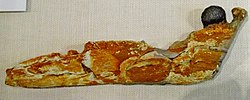
Eudimorphodon was a pterosaur that was discovered in 1973 by Mario Pandolfi in the town of Cene, Italy and described the same year by Rocco Zambelli. The nearly complete skeleton was retrieved from shale deposited during the Late Triassic, making Eudimorphodon one of the oldest pterosaurs known. It had a wingspan of about 100 centimeters (3.3 ft) and at the end of its long bony tail may have been a diamond-shaped flap like in the later Rhamphorhynchus. If so, the flap may have helped it steer while maneuvering in the air. Eudimorphodon is known from several skeletons, including juvenile specimens.
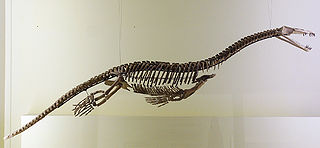
Nothosaurus is an extinct genus of sauropterygian reptile from the Triassic period, approximately 240–210 million years ago, with fossils being distributed from North Africa and Europe to China. It is the best known member of the nothosaur order.

Lariosaurus is an extinct genus of nothosaurid from the Middle Triassic of central and western Europe and China. With a complete specimen of L. xingyiensis measuring 70.5 cm (2.3 ft) long and L. hongguoensis possibly measuring up to 80 cm (2.6 ft) long, it was one of the smallest known nothosaurs. First discovered at Perledo on the Lake Como in 1830, it was named in 1847 by Curioni, its name meaning "Lizard from Larius", the ancient name of the lake. This makes it one of the earliest studied reptiles from the Alps. It is known from an almost complete skeleton holotype and several other fairly complete fossils.
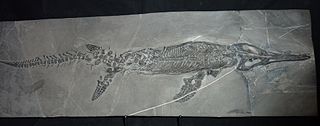
Mixosaurus is an extinct genus of Middle Triassic ichthyosaur. Its fossils have been found near the Italy–Switzerland border and in South China.
Caviramus is a genus of caviramid pterosaur from the Late Triassic lower Kössen Formation of the Northern Calcareous Alps of Switzerland.
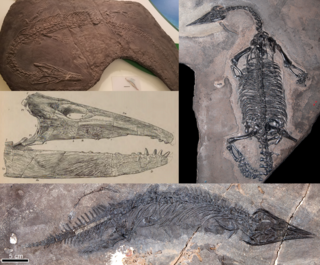
Thalattosauria is an extinct order of prehistoric marine reptiles that lived in the middle to late Triassic period. Thalattosaurs were diverse in size and shape, and are divided into two superfamilies: Askeptosauroidea and Thalattosauroidea. Askeptosauroids were endemic to the Tethys Ocean, their fossils have been found in Europe and China, and they were likely semiaquatic fish eaters with straight snouts and decent terrestrial abilities. Thalattosauroids were more specialized for aquatic life and most had unusual downturned snouts and crushing dentition. Thalattosauroids lived along the coasts of both Panthalassa and the Tethys Ocean, and were most diverse in China and western North America. The largest species of thalattosaurs grew to over 4 meters (13 feet) in length, including a long, flattened tail utilized in underwater propulsion. Although thalattosaurs bore a superficial resemblance to lizards, their exact relationships are unresolved. They are widely accepted as diapsids, but experts have variously placed them on the reptile family tree among Lepidosauromorpha, Archosauromorpha, ichthyosaurs, and/or other marine reptiles.

Omphalosaurus is an extinct genus of marine reptile from the Early Triassic to Middle Triassic, thought to be in the order of Ichthyosauria. Most of what is known about Omphalosaurus is based on multiple jaw fragments, ribs, and vertebrae. Specimens of Omphalosaurus have been described from the western United States, Poland, Austria and the island of Spitsbergen off the northern coast of Norway.
Chinchenia is an extinct genus of a basal pistosauroid known from the Middle Triassic of Guizhou Province, southwestern China. It contains a single species, Chinchenia sungi.
Crenilepis is an extinct genus of prehistoric bony fish that lived in the seas of present-day Europe during the Anisian stage of the Middle Triassic epoch.

Phalarodon is an extinct genus of mixosaurid ichthyosaur known from the Middle Triassic. Its name is derived from the Greek φάλαρα (phálara) and odon ("tooth"). The genus has had a tumultuous history since its classification in 1910, with different workers describing species under different genera or declaring the genus to be a nomen dubium. Currently three species are recognized, but more have been identified in the past.

Qianichthyosaurus is an extinct genus of ichthyosaur from the Ladinian and Carnian stages of the Late Triassic epoch. Its fossils have been found in southeastern China, in Carnian rocks of the Falang Formation near Huangtutang, Guizhou. The type species is Qianichthyosaurus zhoui, named by Chun Li in 1999. A second species, Qianichthyosaurus xingyiensis, was named from older (Ladinian) deposits in the Falang Formation in 2013 by Pengfei Yang and colleagues. Complete Qianichthyosaurus fossils are common in the Xiaowa Formation, with both juveniles and pregnant specimens being known; its larger contemporaries, Guizhouichthyosaurus and Guanlingsaurus, are rarer.
Wimanius is a genus of ichthyosaur from the Middle Triassic of Switzerland, containing a single species, Wimanius odontopalatus. It was described by Michael Maisch and Andreas Matzke in 1998 based on an incomplete skull from Monte San Giorgio, a mountain on the Swiss-Italian border. Wimanius possesses teeth on its palate, though whether they were located on the palatine or pterygoid is disputed. Other features of Wimanius include a large orbit and jugals with two rami of similar lengths. Different phylogenetic placements of Wimanius have been recovered by different studies, including it being a mixosaurid relative or a merriamosaur, and a monotypic family, Wimaniidae has been named for it. However, its validity has also been questioned, and synonymy with various other genera has been proposed.

Simosaurus is an extinct genus of marine reptile within the superorder Sauropterygia from the Middle Triassic of central Europe. Fossils have been found in deposits in France and Germany that are roughly 230 million years old. It is usually classified as a nothosaur, but has also been considered a pachypleurosaur or a more primitive form of sauropterygian.

Sinosaurosphargis is an extinct genus of basal marine saurosphargid reptile known from the Middle Triassic Guanling Formation of Yunnan and Guizhou Provinces, southwestern China. It contains a single species, Sinosaurosphargis yunguiensis.
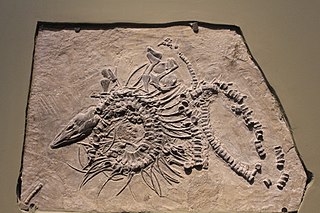
Xinpusaurus is an extinct genus of thalattosaur from the Late Triassic of Guanling in Guizhou, China. Several species have been named since 2000: the type species X. suni along with the species X. bamaolinensis and X. kohi. A 2013 study proposed that all three species are synonymous with each other, in which case X. suni would be the only valid species, although a 2014 study argued that X. kohi was also valid. A fourth species, X. xingyiensis, was described in 2016.
Xinminosaurus is an extinct genus of cymbospondylid ichthyosaur known from the Middle Triassic of Guizhou Province, China.

Saurosphargidae is an extinct family of marine reptiles known from the Early Triassic and early Middle Triassic of Europe and China.
Saurosphargis is an extinct genus of a basal marine reptile, saurosphargid, known from the Middle Triassic of southwestern Poland and eastern Netherlands. It contains a single species, Saurosphargis volzi.

Eusaurosphargis is an extinct genus of a diapsid reptile, known from the Middle Triassic Besano Formation of northern Italy and Prosanto Formation of south-eastern Switzerland. It contains a single species, Eusaurosphargis dalsassoi. It was a small reptile, measuring 20 cm (7.9 in) long.
Agkistrognathus is an extinct genus of thalattosaurian which lived in the early to middle Triassic of British Columbia, Canada. There is only one species known in this genus, Agkistrognathus campbelli. The genus name translates to "hook jaw" while the species name refers to Bob Campbell, who discovered the only known specimen.
